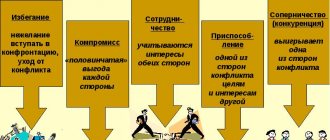BzBook.ru
In relation to an individual subject, conflicts are internal and external. The first includes intrapersonal conflicts, the second interpersonal, between an individual and a group, and intergroup.
Intrapersonal conflict is caused by a person’s contradiction with himself. Most often, it is generated when a person is faced with a discrepancy between external requirements and internal positions and motivation (dissatisfaction with work, inability to realize one’s labor potential), or when the problem arises of choosing one of several possible and desired options (role conflict).
Interpersonal conflict. The most common one involves two or more individuals if they perceive themselves as being in opposition to each other in terms of goals, values or behavior (problems of resource distribution in a team, disputes over a vacant job, divergence of views, etc.). For a leader, such conflicts present the greatest difficulty.
Conflicts between the individual and the group. They are mainly due to the discrepancy between individual and group norms of behavior. Anyone who does not perceive them becomes in opposition, risks being left alone and being unrecognized by the collective.
Intergroup conflicts, i.e. between groups (formal and informal), as well as between trade unions and administration. Such conflicts are usually active and involve a large number of employees, making them difficult to resolve.
Depending on the organizational levels to which the parties belong, conflicts are divided into:
– horizontal – between individual areas of activity in an organization, between formal and informal teams, etc.;
– vertical – between different levels of the hierarchy, the majority of them, about 70–80%;
– mixed, containing elements of both vertical and horizontal conflicts.
According to the area of origin and development, conflicts can be divided into:
– business related to the official activities of a person, with the performance of business duties;
– personal, affecting informal relationships.
According to the distribution of losses and gains between the parties, conflicts are divided into:
– symmetrical, with equal distribution of the results of the conflict;
– asymmetrical, when some lose or win significantly more than others.
According to the degree of manifestation, conflicts are divided into:
- hidden, usually affecting two people who for the time being try not to show that they are in conflict. Hidden conflicts often develop in the form of intrigue, which is understood as a deliberate dishonest action beneficial to the initiator, which forces a group or individual to certain actions and thereby causes damage to the collective and individual;
– open, under the control of management, so they are less dangerous for the organization.
By nature, conflicts are usually divided into:
– objective, related to real problems and shortcomings that arise in the process of functioning and development of the organization, i.e. they have a business basis;
– subjective are caused by differences in individual assessments of certain events and relationships between people. They are always emotional and often result from the psychological incompatibility of people, their misunderstanding and unwillingness to understand each other. According to their consequences, conflicts are:
– constructive, contributing to the development of the organization. However, any constructive conflict, if not overcome in a timely manner, turns into destructive;
– destructive, causing damage to the organization. It is important to know that the division of conflicts into types is arbitrary.
Each conflict has its own cause (source) of occurrence. The reasons that give rise to conflicts can be divided into three groups: those arising in the process of work, caused by the psychological characteristics of human relationships, and determined by the personal characteristics of the organization’s employees.
The first group includes:
– insufficient coherence and inconsistency of the goals of individual groups and workers, due to the lack of clarity in setting the goals and objectives of each department and employee, poor organization of the labor process;
– task interdependence, where one person or group depends on another person or group to complete a task;
– fatigue of the organizational structure, unclear distribution of rights and responsibilities, giving rise to double or triple subordination of performers. As a result, the subordinate is forced to either rank incoming orders according to their degree of importance, or demand this from his immediate superior, or grab onto everything;
– limited resources, and the allocation of a larger share of resources to one will mean that other members of the team will not receive them, which will cause dissatisfaction and lead to conflicts;
– unsatisfactory communication link. Workers who do not have reliable information cannot understand the situation or the point of view of others;
– insufficient level of professional training, as a result, such an employee is not trusted to perform certain types of work, so some workers are overloaded with work, while others are overloaded with it;
– unfavorable physical conditions, such as extraneous noise, heat or cold, poor workplace layout;
– uncertainty of growth prospects, while the employee works without enthusiasm, and the labor process becomes painful and endless for him.
The second group includes the psychological phenomenon of a person, manifested in feelings of resentment and envy; mutual likes and dislikes of people.
The third group includes such causes of conflicts as contradictions between the functions included in the employee’s job responsibilities and what he is forced to do at the request of the manager, if the manager is prone to bureaucratic procedures; unfounded public censure of some and undeserved praise of other employees; differences in behavior and life experiences. There are aggressive and hostile people who cannot control their emotions. Differences in life experience, values, education, length of service, age and social characteristics reduce the degree of mutual understanding and cooperation in the work team; lack of benevolent attention on the part of the manager, his intolerance to criticism, inattention to the needs and problems of subordinates, etc.
Reasons are the causes of conflicts only when they make it impossible for an individual or group to realize their needs, or affect personal and group interests. The individual’s reaction is largely determined by the social maturity of the individual, acceptable forms of behavior for him, and social norms and rules accepted in the team. In certain situations, the source of the conflict becomes the leader himself, the manager, especially if he is inclined to bring a lot of petty things into the fundamental struggle of opinions, and allows himself personal attacks, is vindictive and suspicious, and does not hesitate to publicly demonstrate his likes and dislikes.
The causes of the conflict may be such characteristics of the leader as unprincipledness, his false understanding of unity of command as a principle of management, vanity and arrogance, harshness and rudeness in communicating with subordinates.
There are several tactics for resolving conflicts; they lie in the plane of interpersonal relationships and can be represented by five main styles.
Style of avoiding or avoiding conflict. It is associated with a lack of personal persistence and desire to cooperate with others with its permission. If the conflict has objective reasons, this approach is favorable, because it gives them the opportunity to calm down, comprehend the situation and come to the conclusion that there is no basis for the confrontation and its continuation is pointless. If the conflict is objective, then the tactics of avoiding the conflict lead to loss for both its participants and the organization as a whole, since time drags on, and the reasons that caused the conflict not only persist, but may even worsen.
Smoothing (adjustment) style. It is used when one of the parties is not interested in the subject of the conflict, its rank turns out to be higher, and it provides the other party with the opportunity to get what is more important to it, while it itself remains without winning, but does not lose. This style reduces the intensity of passions, allows you to comprehend the situation and maintain good relationships. However, although the owners of this style are assessed positively by others, they are often perceived by others as weak natures, easily susceptible to the influence of others.
Coercion style (resolving conflicts by force in one’s favor). Characterized by great personal involvement and interest in eliminating the conflict, but without taking into account the position of the other side. Force them to accept their point of view at any cost. To use this style, you must have power or physical advantages, so it is often accompanied by illicit force, intimidation, blackmail, etc.
The disadvantages of this method are: suppression of the initiative of subordinates, the possibility that all important factors will not be taken into account, since only one point of view is represented and dominates. At the same time, others develop an unfavorable opinion about the individual using this style.
The compromise style is behavior in resolving interpersonal conflict that moderately takes into account the interests of each party. Since both sides are not losers, this style is widely used in practice, but, as a rule, it is not possible to make an optimal decision, since the problem itself remains unresolved. Compromise allows you to save the relationship and gain something instead of losing everything. According to management experts, choosing a compromise strategy is the best way to eliminate contradictions. However, using compromise early in a conflict over an important issue may hinder the search for alternatives.
Style of problem solving (final resolution of conflict). Involves recognizing differences of opinion and being willing to engage with other points of view in order to understand the causes of the conflict and find a course of action acceptable to all parties. Using this style benefits everyone. Firstly, opponents become partners, and therefore the situation in the organization improves. Secondly, the problem is resolved and ceases to exist. Thirdly, the benefits acquired by the parties, even if they are distributed unevenly, still exceed those that could be obtained using any other style. This style is based on an attitude towards conflict as a normal phenomenon, which nevertheless must be overcome and eliminated.
The specific use of a particular style depends on the nature of the behavior of the participants in the conflict.
Conflict management is a targeted impact on eliminating (minimizing) the causes of the conflict or correcting the behavior of the participants in the conflict, changing their goals.
A manager should not eliminate conflict, but manage it and use it effectively. The first step in managing conflict is to understand its sources. The manager should find out: is this a simple dispute about resources, a misunderstanding on some problem, different approaches to people’s value systems, or is it a conflict that has arisen as a result of mutual intolerance or psychological incompatibility. After determining the causes of the conflict, he must minimize the number of its participants, because the fewer people involved in the conflict, the less effort will be required to resolve it.
There are three points of view on the conflict:
1) the manager believes that the conflict is unnecessary, it only causes harm to the organization, so it must be eliminated by any means;
2) conflict is an undesirable but common by-product of any organization, and a manager must eliminate conflict wherever it arises;
3) conflict is not only inevitable, but also necessary and potentially useful, and this is a completely normal phenomenon. Depending on the point of view on the conflict that the manager adheres to, the procedure for overcoming it will depend. In this regard, there are two large groups of conflict management methods:
– pedagogical (conversation, request, persuasion, explanation of work requirements and unlawful actions of those in conflict);
– administrative (forceful resolution of conflict, resolution by order).
To resolve organizational conflicts, structural methods of conflict management within the organization are used, associated with the use of changes in the structure of the organization and aimed at reducing the intensity of the conflict. These methods include:
– clarification of job requirements, i.e., what results are expected from each employee and department within the framework of delegation of authority and responsibility, clearly formulated policies and certain rules of behavior in the organization;
– application of coordination and integration mechanisms. The first, the most common, is the sequential application of a chain of command, which organizes the interaction of people within the framework of an established hierarchy of authority. To implement integration, the creation of special services and task forces is used to communicate between functions within the management structure;
– establishing an organization-wide set of goals, the implementation of which requires the joint efforts of two or more employees or departments. It is important that each participant clearly understands their place and role in the overall process;
- the use of a reward system that can be used to positively influence people's behavior if the manager sees that individual employees are effectively helping to achieve organization-wide goals and try to approach problems in an integrated manner. The reward system should not encourage unconstructive behavior by individuals and groups. The systematic use of a reward system helps people quickly understand the basic rules of behavior in a team and in conflict situations. Thus, conflict situations in labor collectives of organizations are manageable. In complex situations, when a variety of approaches and accurate information are significant factors influencing decision-making, managers must promptly identify emerging conflicts and resolve them, and in some cases, encourage the emergence of situations and manage them to resolve problems.
Content








